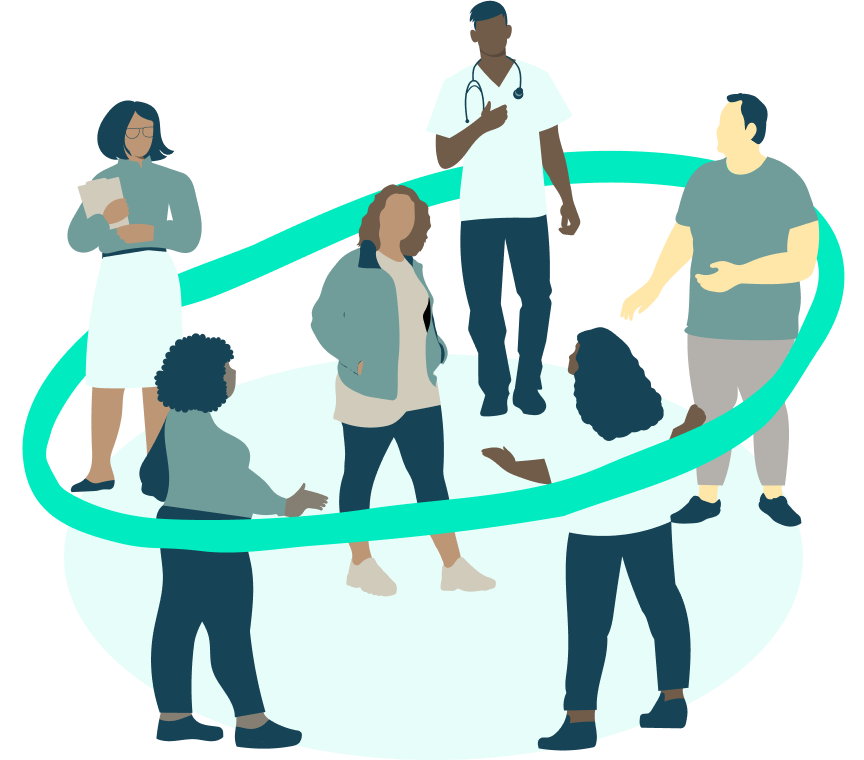OSFED Treatment
OSFED, which stands for other specified feeding and eating disorder, is an umbrella diagnosis that includes a number of different types of eating disorders that don’t fit neatly into other diagnostic categories.
Because OSFED can feel more general than other eating disorders, some people mistakenly think it’s not as serious. This isn’t true: OSFED has just as many health risks as eating disorders like anorexia and bulimia, and it requires professional treatment.
Read on to learn more about OSFED, what treatment looks like, and when to seek help.

What is OSFED?
The OSFED diagnosis encompasses various different eating disorders that don’t fit the diagnostic criteria for the other disorders in the Diagnostic and Statistical Manual of Mental Disorders (DSM). It’s a general diagnosis for people who experience physical, mental, and emotional distress related to food, but don’t match the description for bulimia, anorexia, binge eating disorder, or ARFID.
Types of OSFED
Some of the specific types of OSFED include:
- Atypical anorexia nervosa
- Purging disorder
- Limited or infrequent binge eating
OSFED was previously referred to as EDNOS, or eating disorder not otherwise specified, before the category was changed in 2013 in the DSM-5. The terms are different, but mean essentially the same thing.
Risks of OSFED
While OSFED isn’t as specific as other eating disorders, it’s just as serious: OSFED poses the same mortality risk as anorexia and bulimia, and children with OSFED are just as likely to be hospitalized from the complications of their eating disorder as those with bulimia or anorexia. OSFED affects about 5% of the U.S. population.
What OSFED treatment looks like
Because every instance of OSFED is different, treatment looks different from person to person: someone with OSFED who has night eating syndrome will have a totally different treatment plan than someone with purging disorder, for instance. Still, there are some elements that will be the same regardless of how someone’s OSFED shows up.Treatment for OSFED is multifaceted. Some of its components include:
Weight restoration
The first step for all eating disorder treatment is weight restoration, if it’s needed. If OSFED has led to malnourishment, it’s important to address any nutritional deficiencies and reach a stable weight before anything else. Without laying the physical groundwork, your brain and body won’t be able to fully engage with or make progress in treatment.
Normalizing eating behaviors
After any malnutrition is addressed, the next step is to establish normal eating habits. This is generally done by working with a dietitian to develop a meal plan, and beginning to eat regular meals and snacks throughout the day. No matter what sort of OSFED symptoms a person is experiencing, normalizing eating patterns will help to address them.
Individual therapy
OSFED treatment will also include individual therapy to work through root causes of the eating disorder, identify triggers, develop healthy coping skills, and address co-occurring conditions like anxiety or depression, among other goals. If your loved ones are involved in your recovery journey, treatment will also include family therapy to help your supports better understand your eating disorder and how they can support you.
When to treat OSFED
If you’re concerned about your thoughts or behaviors around food, weight, or your body, don’t ignore it. Even if you don’t fit the description of one of the commonly known diagnoses, you may still have an eating disorder, and the disordered behaviors associated with OSFED can do real harm to your body, mind, and quality of life. OSFED, like all eating disorders, requires comprehensive treatment, and the sooner you seek help, the better your odds of achieving lasting recovery (though it’s never too late to get help).
It can be tricky to determine if you or a loved one are struggling with OSFED, because the symptoms can vary widely from person to person. You can learn more about OSFED symptoms here, but if you’re concerned about your or a loved one, the safest bet is to get an assessment from an eating disorder professional.Take our interactive eating disorder screener
What does OSFED treatment look like at Equip?
OSFED as a diagnosis doesn't fit neatly into a box, and neither does its treatment. Care at Equip is always individualized to each patient’s needs and challenges, and this is especially true with OSFED.
Though the specifics of treatment might vary, every patient at Equip is matched with a dedicated 5-person care team. Your team will include :
Your team will include:
Licensed therapist
Your therapist will use leading evidence-based approaches to help you navigate the thoughts and feelings contributing to your eating disorder and manage challenges that arise during treatment. They’ll also help manage co-occurring mental health conditions, teach you healthy coping and emotion regulation skills, and support the development of a positive self-image with support from your loved ones.
Registered dietitian
Your dietitian will help you develop and stick to a meal plan, normalize your eating habits, and provide in-depth nutrition education so that you can better understand your body’s needs. Telehealth visits make it easy for you and your dietitian to work together in your own kitchen, so they can coach you through preparing food.
All Equip dietitians are registered dietitians (RDs) or registered dietitian nutritionists (RDNs).
Medical provider
After you’re medically cleared for treatment, your Equip medical provider monitors your weight and vitals, stays on top of any existing medical issues, and manages any prescriptions. They’ll also help you address any physical symptoms that may arise as you progress through treatment.
Peer mentor
Each patient works one-on-one with an experienced peer mentor who has made a full recovery from their eating disorder. For patients with OSFED, having this kind of understanding and validation can be particularly important.
Family mentor
Each patient’s chosen support people will connect with another person who has supported a loved one through eating disorder recovery. They’ll provide empathy and support, as well as practical advice for navigating the toughest parts of recovery.
Your first week and beyond
During your first week of OSFED treatment at Equip, you’ll meet with each member of your care team and get a personalized treatment plan that’s tailored to fit your life and your needs. As you move toward recovery, sessions will taper off, and we’ll continue to monitor progress and adjust our treatment approach if something’s not working. In addition to provider sessions, you’ll also have the opportunity to join various different support groups.
The first focus of treatment is stopping disordered behaviors, establishing regular eating habits, and achieving weight restoration if needed. Once you’ve been able to normalize your eating habits and make progress toward restoring your weight (if necessary), the focus of treatment can shift to other areas. That might mean working on interpersonal relationships, setting goals outside of the eating disorder, learning to handle triggers in your daily life, or understanding potential root causes of the eating disorder.
All our treatments are delivered virtually, so you’ll be working on changing your behaviors and processing your feelings in the environments where you live and eat. Equip is flexible enough to meet you and any supporting friends or family members wherever you are.

Treatment modalities we use at EquipWe use the following evidence-based treatment modalities to treat patients with OSFED:
Enhanced cognitive behavioral therapy is a form of CBT designed specifically for treating eating disorders. It’s a flexible and powerful framework that helps you reflect on how strategic behavioral changes impact your OSFED symptoms and thought patterns.
Dialectical behavioral therapy helps you learn skills that make intense or distressing emotions more manageable. DBT skills provide you alternative ways of coping with challenging moments, rather than turning to disordered behaviors.
Exposure and response prevention is an approach that helps you face any fears contributing to your eating disorder in a safe space. Through ERP, you’ll build emotional resilience and self-compassion as you understand those fears and the behaviors they’re linked to.
Family-based treatment is the leading approach for treating eating disorders in young people. It empowers healthy family members to take a central role in their loved one’s eating disorder treatment, providing the accountability and support they need to recover at home.
Recovery is possible
Having an eating disorder can feel isolating, and this is particularly true of a lesser known and poorly understood diagnosis like OSFED. But you’re not alone, and recovery is possible.
If you’re concerned that you or a loved one may be dealing with OSFED, don’t wait to get help.
Get in touch with our team today to learn more about OSFED treatment at Equip or to schedule a free consultation.
Take the next step
Privacy PolicyNotice of Privacy PracticesSecurity PolicyTerms & ConditionsGood Faith EstimateYour Privacy Choices
All names, likenesses, and identifying information have been changed in accordance with privacy laws. Images are of models, not actual patients.
Your privacy is Equip's priority, we safeguard your health information with end-to-end data encryption and industry-leading secure cloud practices. Our platform is HIPAA-compliant and SOC2 certified, ensuring your data is always protected.
